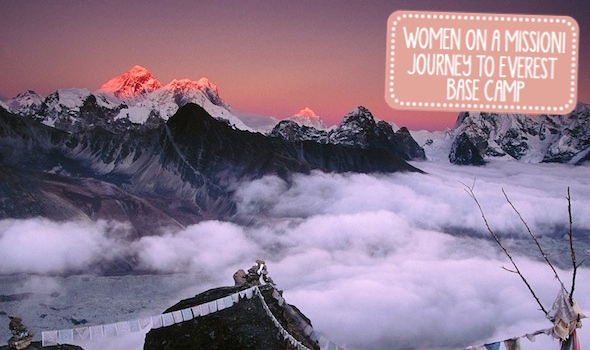
Everest base camp is any budding mountaineer’s dream. This emblematic site, from which countless attempts to summit this goddess of all mountains have been made commands nothing but respect and humility. Standing there, a little breathless (from both the excitement and the 60% oxygen levels!), gazing admiringly at the Khumbu Icefall jaggedly rising before us and surrounded by majestic snowy peaks… it’s hard not to imagine the legendary climbers that have trodden where we stood.
 Just over half a century ago, Sir Edmund Hillary and Tenzing Norgay first climbed Mount Everest using this route; forging a path through the treacherous Khumbu Icefall at our feet.
Just over half a century ago, Sir Edmund Hillary and Tenzing Norgay first climbed Mount Everest using this route; forging a path through the treacherous Khumbu Icefall at our feet.
My all-female teammates and I had been dreaming of this moment for many months while training hard to be in the best possible physical and mental shape for this demanding trek. As we savoured the feeling on this windy autumn afternoon, despite the sun shining brightly in the cloudless azure sky, at 5364 metres of altitude it was already a chilly -3 degrees. We didn’t have much time before the sun moved behind the mountains and the temperatures plummeted to a crisp -15 degrees. So it was with haste that we unfurled our various banners to take the pictures we’d planned to capture.
The long days of non-stop trekking had taken its toll on our team. Three of our members were on antibiotics, and at our last stop of Gorak Shep at 5164 m, two of our teammates had needed oxygen masks.
It had been touch-and-go as to whether we’d all make it from that point. We had discussed whether these teammates should in fact start their descent immediately, instead of continuing onto base camp with us. They had endured pounding headaches that didn’t ease with medication for the last three days – a sure sign of altitude sickness – and definitely not something to be taken lightly. That very morning, a French climber had been airlifted due to altitude sickness. After receiving oxygen, our teammates felt marginally better, and having come so far together we chose to accomplish our mission collectively.
The added motivation was that we had committed to this challenge in order to raise awareness and funds (a total of $100,000 SGD, to be exact!) for women survivors of war around the world with Women For Women International. Throughout the most strenuous moments of the climb, this mission had given us added strength and endurance. We felt incredibly grateful to be able to partake in such a special adventure and as a result, to hopefully make a difference in their lives.
After our base camp photography session (and naturally, a short celebration!) some of the ladies opted to head back down to lower altitude for the night.
Owing to our expedition guides’ license and connections, the rest of us were granted the very special permission of sleeping at base camp. This privilege is usually only accorded to teams attempting to summit Everest itself. Our trek leader, Valery Boffy, had accomplished this incredible feat just a few months earlier on May 19th, 2012 during the second deadliest season Everest had ever seen. Eleven climbers had lost their lives, and it’s no secret that the flanks of Everest are the final resting place of plenty of mountaineers, who died while attempting to summit the tallest mountain in the world.
 Famous for its spectacular mountain peaks and the loyalty and friendliness of its inhabitants, the Sherpas, the Everest region is one of the most popular destinations for hikers in Nepal. The journey to Everest base camp can take approximately ten days to two weeks, depending on how many days of acclimatisation you allow.
Famous for its spectacular mountain peaks and the loyalty and friendliness of its inhabitants, the Sherpas, the Everest region is one of the most popular destinations for hikers in Nepal. The journey to Everest base camp can take approximately ten days to two weeks, depending on how many days of acclimatisation you allow.
This trek is classified as moderate to difficult, although it’s not the terrain or hours on the trail (between 5 to 8 hours per day, depending on itinerary,) that are the real difficulty – it’s the altitude.
Starting from the village of Lukla, a short and scenic flight from Kathmandu, we landed at Tenzing-Hillary Airport, considered one of the most dangerous airports in the world. The single runway is tiny, with a 12% gradient. On one side you have mountains; on the other – a sheer drop into nothingness, so it’s no surprise that we were holding our collective breath (and the edge of our seats!), as the pilot came in for the precarious final approach.
 While many routes through the mountains are arduous, there are ample places to rest and enjoy a meal along the way. Furthermore, it’s almost impossible to get lost; all you have to do is ask a local the way to the next village on your route, and they will direct you. The Nepalese people we met on this incredible journey touched our hearts forever with their warmth and kindness.
While many routes through the mountains are arduous, there are ample places to rest and enjoy a meal along the way. Furthermore, it’s almost impossible to get lost; all you have to do is ask a local the way to the next village on your route, and they will direct you. The Nepalese people we met on this incredible journey touched our hearts forever with their warmth and kindness.
From Lukla we made our way to Monjo following the path to the Sherpa capital of Namche Bazaar at 3440m, passing through the Sagarmatha Park. Altitude sickness can affect even the fittest people, and warnings about this are plastered along the way into Namche. Acute mountain sickness or AMS is no joke in the Khumbu Valley, and from Monjo to Namche is about 5 km, four hours of which are almost all uphill. This part of the journey was quite challenging and seemed interminable at times! We spent two nights in Namche to allow for acclimatisation, hiking up to the Everest View Hotel at 3750m.
At Namche Monastery we met the local Lama and received his blessing for the journey ahead. One of the most enjoyable facets of this trek was the spiritual journey we made in the land of the clouds and as we progressed through the various villages that took us to Everest base camp, we came across temples, monasteries, prayer wheels and stone tablets depicting the life of the Dalai Lama.
 As we continued from Namche, we passed through the beautiful village of Tangboche, which claims the highest monastery in the world. The air started to feel thin at this level, as we stopped for a quick lunch on our way up to Pangboche at 3930m, where we spent another two nights.
As we continued from Namche, we passed through the beautiful village of Tangboche, which claims the highest monastery in the world. The air started to feel thin at this level, as we stopped for a quick lunch on our way up to Pangboche at 3930m, where we spent another two nights.
The next day was an important acclimatisation day, with a five-hour hike to Amadablam base camp (4460m) and back. Having lunch with the climbers and Sherpas camping at at Amadablam for weeks at a time as they prepared for their assault on the summit gave us a real sense of how a fully active expedition camp operated.
 The next stop was Dingboche, an eight-hour walk from Pangboche, followed by Dzongla the next day, taking us above the tree line to the Cholatse Pass. The terrain started to appear moon-like at this level, with spectacular views of the lake and stunning peaks.
The next stop was Dingboche, an eight-hour walk from Pangboche, followed by Dzongla the next day, taking us above the tree line to the Cholatse Pass. The terrain started to appear moon-like at this level, with spectacular views of the lake and stunning peaks.
 Finally, on the ninth day we made it to the last lodge at Gorak Shep, a staggering 5140m up, where we spent a night. We were not far now, but some of us started to show real signs of fatigue as the thin air began taking its toll on our bodies. The next morning at 4am, a few of us set out in complete darkness to climb Kala Patthar mountain peak. From there we were able to catch an awe-inspiring and unobstructed view of Mount Everest at sunrise. After lunch that same day, our team finally made our way to Everest base camp…
Finally, on the ninth day we made it to the last lodge at Gorak Shep, a staggering 5140m up, where we spent a night. We were not far now, but some of us started to show real signs of fatigue as the thin air began taking its toll on our bodies. The next morning at 4am, a few of us set out in complete darkness to climb Kala Patthar mountain peak. From there we were able to catch an awe-inspiring and unobstructed view of Mount Everest at sunrise. After lunch that same day, our team finally made our way to Everest base camp…
Our mission accomplished, the descent from base camp to Lukla took about three days and despite the sudden drop in altitude with a welcome increase of oxygen levels in the air, those days felt long and tiring. By now, we were all just ready to come home.
 As we were journeying with dear friends, this made for wonderful camaraderie and outbreaks of hysterical laughter along the way. That said, our trek leader is a formidable woman, whom we admired and respected and who knew the terrain like the back of her hand. Valerie’s drive and determination inspired and motivated us throughout the journey, and we had complete confidence in her ability to lead us on this incredible adventure.
As we were journeying with dear friends, this made for wonderful camaraderie and outbreaks of hysterical laughter along the way. That said, our trek leader is a formidable woman, whom we admired and respected and who knew the terrain like the back of her hand. Valerie’s drive and determination inspired and motivated us throughout the journey, and we had complete confidence in her ability to lead us on this incredible adventure.
Despite the constant longing for clean toilets and hot running water (not to mention the close shaves with aggressive yaks!) – all the hardships we endured were long forgotten once we found ourselves in the warm embrace of our families back home.
For more on Christine and the amazing Women on a Mission, check out their Facebook page or better yet, you can donate to their Women for Women International appeal here.
Christine Amour-Levar is a self-described “work-in-progress” Mum, Wife, Freelance Writer, Editor, and Marketing Consultant. She is the Author of The Smart Girl’s Handbook to Being MUMMYLICIOUS – a motivational and practical guide to getting your body (and your GROOVE) back post pregnancy – now available at Metrobooks in Hong Kong’s Elements Mall, Langham Place & Mikiki in Kowloon. For more information please visit: www.thesmartgirlshandbook.com






 View All
View All




 View All
View All











 View All
View All











